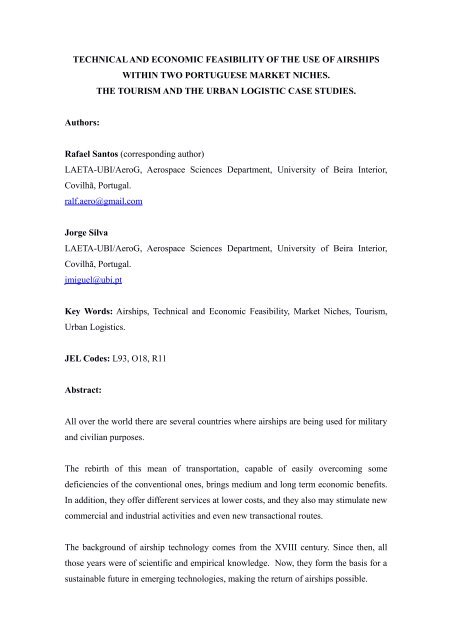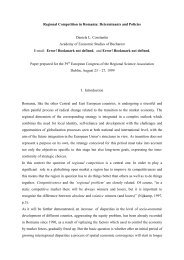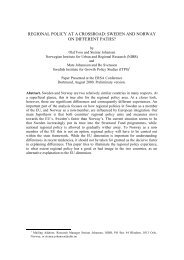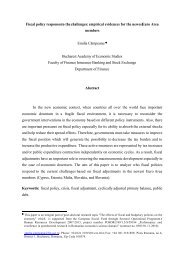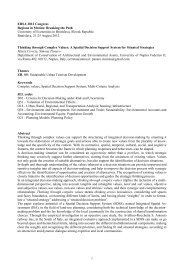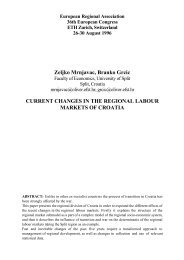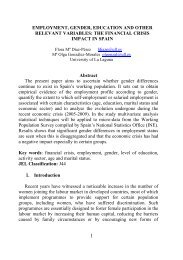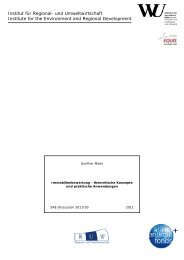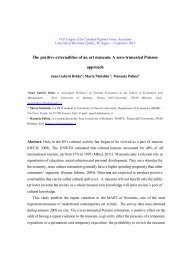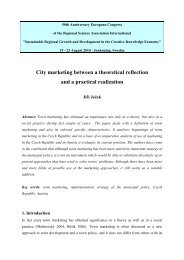technical and economic feasibility of the use of airships within two ...
technical and economic feasibility of the use of airships within two ...
technical and economic feasibility of the use of airships within two ...
You also want an ePaper? Increase the reach of your titles
YUMPU automatically turns print PDFs into web optimized ePapers that Google loves.
TECHNICAL AND ECONOMIC FEASIBILITY OF THE USE OF AIRSHIPS<br />
Authors:<br />
WITHIN TWO PORTUGUESE MARKET NICHES.<br />
THE TOURISM AND THE URBAN LOGISTIC CASE STUDIES.<br />
Rafael Santos (corresponding author)<br />
LAETA-UBI/AeroG, Aerospace Sciences Department, University <strong>of</strong> Beira Interior,<br />
Covilhã, Portugal.<br />
ralf.aero@gmail.com<br />
Jorge Silva<br />
LAETA-UBI/AeroG, Aerospace Sciences Department, University <strong>of</strong> Beira Interior,<br />
Covilhã, Portugal.<br />
jmiguel@ubi.pt<br />
Key Words: Airships, Technical <strong>and</strong> Economic Feasibility, Market Niches, Tourism,<br />
Urban Logistics.<br />
JEL Codes: L93, O18, R11<br />
Abstract:<br />
All over <strong>the</strong> world <strong>the</strong>re are several countries where <strong>airships</strong> are being <strong>use</strong>d for military<br />
<strong>and</strong> civilian purposes.<br />
The rebirth <strong>of</strong> this mean <strong>of</strong> transportation, capable <strong>of</strong> easily overcoming some<br />
deficiencies <strong>of</strong> <strong>the</strong> conventional ones, brings medium <strong>and</strong> long term <strong>economic</strong> benefits.<br />
In addition, <strong>the</strong>y <strong>of</strong>fer different services at lower costs, <strong>and</strong> <strong>the</strong>y also may stimulate new<br />
commercial <strong>and</strong> industrial activities <strong>and</strong> even new transactional routes.<br />
The background <strong>of</strong> airship technology comes from <strong>the</strong> XVIII century. Since <strong>the</strong>n, all<br />
those years were <strong>of</strong> scientific <strong>and</strong> empirical knowledge. Now, <strong>the</strong>y form <strong>the</strong> basis for a<br />
sustainable future in emerging technologies, making <strong>the</strong> return <strong>of</strong> <strong>airships</strong> possible.
This revived interest in airship technology brings a multitude <strong>of</strong> <strong>technical</strong> concepts<br />
resulting from interdisciplinary research. Consequently, <strong>the</strong> state <strong>of</strong> art <strong>of</strong> <strong>airships</strong><br />
presents new research which paves <strong>the</strong> way for <strong>the</strong> reappearance <strong>of</strong> renewed horizons<br />
with regards to <strong>the</strong> <strong>use</strong> <strong>of</strong> <strong>airships</strong>. Companies are foc<strong>use</strong>d on <strong>the</strong> research, development<br />
<strong>and</strong> testing <strong>of</strong> new airship concepts <strong>and</strong> designs too.<br />
Nowadays, <strong>airships</strong> are being studied for commercial transport in different parts <strong>of</strong> <strong>the</strong><br />
globe, from Canada, Brazil, Peru, to Australia. India, for example, has studies about <strong>the</strong><br />
connection to remote areas with poor surface infrastructure which only can be reached<br />
by air or walking. This way, it’s expected that <strong>airships</strong> will become a competitive mean<br />
<strong>of</strong> transport to link areas served by deficient transport infrastructures.<br />
Taking <strong>the</strong> principles <strong>of</strong> sustainable development <strong>of</strong> air transport, <strong>airships</strong> are <strong>the</strong> most<br />
environment-friendly vehicles with lower fuel consumption <strong>and</strong> with higher endurance.<br />
Therefore, as a result, <strong>the</strong>y are paving <strong>the</strong> way for new markets.<br />
This work examines <strong>the</strong>se technological improvements <strong>and</strong> <strong>the</strong> <strong>economic</strong> <strong>feasibility</strong> <strong>of</strong><br />
<strong>the</strong> <strong>use</strong> <strong>of</strong> <strong>airships</strong> in certain market niches. Mainly, this work makes <strong>use</strong> <strong>of</strong> a study<br />
concerning <strong>the</strong> viability <strong>of</strong> <strong>the</strong> <strong>use</strong> <strong>of</strong> <strong>airships</strong> <strong>within</strong> Portuguese Tourism <strong>and</strong> Urban<br />
Logistic activity sectors.<br />
This paper is organized as follows: firstly, state <strong>of</strong> <strong>the</strong> art reviews about <strong>airships</strong><br />
technological characteristics, operational constraints, operation scenarios, <strong>and</strong><br />
international <strong>and</strong> national legislation. Secondly, some insights <strong>and</strong> challenges about <strong>two</strong><br />
case studies <strong>within</strong> <strong>the</strong> Portuguese territory (touristic flights <strong>and</strong> urban logistic activity).<br />
And thirdly, some insights <strong>and</strong> challenges <strong>of</strong> (future) research that is still in progress.<br />
1. INTRODUCTION<br />
In <strong>the</strong> beginning <strong>of</strong> its commercial history <strong>the</strong> <strong>airships</strong> (all <strong>of</strong> <strong>the</strong>m called Zep-<br />
pelin) seemed to have a future, until suddenly <strong>the</strong>y lost its merit, visibility <strong>and</strong> was for-<br />
gotten. Now it’s considered by many as a mere curiosity.
Technological progress in materials, aerodynamics, propulsion <strong>and</strong> <strong>the</strong> growing<br />
environmental concern, make <strong>the</strong>se vehicles a more environmentally friendly alterna-<br />
tive, for most <strong>of</strong> <strong>the</strong> <strong>use</strong>rs.<br />
The revival <strong>of</strong> this means <strong>of</strong> transport is able to respond to specific niche mar-<br />
kets <strong>and</strong> easily overcome some shortcomings <strong>of</strong> more conventional means. This pro-<br />
vides medium / long-term <strong>economic</strong> benefits that <strong>of</strong>fer different services at lower costs<br />
<strong>and</strong> can stimulate new commercial <strong>and</strong> industrial activities <strong>and</strong> even new transactional<br />
routes.<br />
2. STATE OF ART<br />
The background <strong>of</strong> airship technology comes from <strong>the</strong> XVIII century. Since<br />
<strong>the</strong>n, all <strong>the</strong>se years were <strong>of</strong> scientific <strong>and</strong> empirical knowledge that act as basis for a<br />
sustainable future in emerging technologies thus making possible <strong>the</strong> return <strong>of</strong> <strong>airships</strong>.<br />
This revived interest in airship technology brings a multitude <strong>of</strong> <strong>technical</strong> concepts re-<br />
sulting from interdisciplinary research. Thus <strong>the</strong> state <strong>of</strong> art <strong>of</strong> airship presents new re-<br />
search that paves <strong>the</strong> way for <strong>the</strong> resurgence <strong>of</strong> renewed horizons for <strong>the</strong> application <strong>of</strong><br />
<strong>airships</strong> including new technologies <strong>of</strong> production far away from <strong>the</strong> archaic ones <strong>use</strong>d<br />
by mid Twentieth century; in fact, companies are foc<strong>use</strong>d on <strong>the</strong> research, development<br />
<strong>and</strong> testing <strong>of</strong> new <strong>airships</strong> concepts <strong>and</strong> designs.<br />
The <strong>use</strong> <strong>of</strong> <strong>airships</strong> for <strong>the</strong> transportation <strong>of</strong> passengers, including <strong>within</strong> <strong>the</strong><br />
tourism sector, is a quite well explore <strong>economic</strong> activity in several countries. The tech-<br />
nology in <strong>use</strong> become each day more sophisticated <strong>and</strong> under safety patterns accepted<br />
for all<br />
However, <strong>the</strong> growing world population, its expansion <strong>and</strong> cities overcrowding,<br />
is creating a traffic jam on air but also ashore. The logistics in large urban centers is as-<br />
sociated with wide ranges <strong>of</strong> problems that affects <strong>the</strong> quality <strong>of</strong> life <strong>of</strong> surrounding<br />
populations <strong>and</strong> hinder <strong>the</strong> performance <strong>of</strong> shipping.<br />
Such problems can be divided into <strong>two</strong> categories: problems that are common to<br />
means <strong>of</strong> transportation in general, <strong>and</strong> <strong>the</strong> road one in particular (emissions <strong>of</strong> pollu-<br />
tants, noise, accidents, congestion) - that have been discussed <strong>and</strong> addressed by a lot <strong>of</strong><br />
investigations, <strong>and</strong> <strong>the</strong> specific problems <strong>of</strong> <strong>the</strong> logistics activities that are usually re-<br />
lated to how <strong>the</strong>se activities are using <strong>the</strong> infrastructure <strong>and</strong> urban space.
The solutions to <strong>the</strong>se problems have been basically <strong>the</strong> <strong>use</strong> <strong>of</strong> “more” road in-<br />
frastructure, already congested. As <strong>the</strong>se solutions are not getting major results, <strong>the</strong><br />
community is turn in into o<strong>the</strong>r solutions, where <strong>the</strong> <strong>use</strong> <strong>of</strong> <strong>airships</strong> can get some advan-<br />
tage.<br />
2.1.Technological Characteristics<br />
The history <strong>of</strong> aviation is closely linked to technological progress, <strong>and</strong> <strong>the</strong> re-<br />
birth <strong>of</strong> <strong>the</strong> airship is due to <strong>the</strong> plunge <strong>of</strong> new technologies in materials <strong>and</strong> structure<br />
fields, without forgetting <strong>the</strong> avionics equipments <strong>and</strong> <strong>the</strong> propulsion systems. The ad-<br />
vance in <strong>the</strong> area <strong>of</strong> structures <strong>and</strong> materials enabled <strong>the</strong> creation <strong>of</strong> tissues capable <strong>of</strong><br />
dissipating only 1% <strong>of</strong> helium per year.<br />
The progress <strong>of</strong> materials <strong>and</strong> structures created a division <strong>of</strong> opinions <strong>and</strong> ac-<br />
cording to Khoury <strong>and</strong> Gillett (2004) <strong>airships</strong> that have a rigid internal structure <strong>of</strong> <strong>the</strong><br />
loading forces on <strong>the</strong> envelope are more balanced than <strong>the</strong> pressurized <strong>airships</strong>. Only<br />
beca<strong>use</strong> this structure being resistant decreases <strong>the</strong> concentration regions <strong>of</strong> tension ef-<br />
forts <strong>and</strong> enables better performance in flight. But for Miller <strong>and</strong> M<strong>and</strong>el (2002), <strong>the</strong><br />
technology <strong>of</strong> <strong>the</strong> fabric must meet all air navigability requirements. Such as <strong>the</strong> materi-<br />
als that compose <strong>the</strong> airship’s envelope have to be tested for stress analysis which must<br />
ensure that <strong>the</strong> ultimate strength <strong>of</strong> <strong>the</strong> envelope cloth is not less than four times <strong>the</strong><br />
maximum loading <strong>of</strong> <strong>the</strong> fabric, as <strong>the</strong> material deteriorates due to <strong>the</strong> cyclical loading<br />
<strong>and</strong> depending on <strong>the</strong> environmental agents.<br />
For NASA (2007) <strong>the</strong> <strong>use</strong> <strong>of</strong> numerous <strong>technical</strong> innovations in a single project<br />
may pose risks that need to be forewarned. It is necessary to analyze technological inno-<br />
vations <strong>and</strong> submit a sufficient number <strong>of</strong> rigorous tests before certifying <strong>the</strong> security <strong>of</strong><br />
its application. It is also necessary to ensure that <strong>the</strong>se tests cover all wea<strong>the</strong>r <strong>and</strong> envi-<br />
ronmental conditions <strong>of</strong> <strong>the</strong> transaction under which <strong>the</strong> aircraft is intended to operate.<br />
2.2. Operational Constraints<br />
Accordingly with Tatievsky (2012) along with <strong>the</strong>ir great potential, <strong>airships</strong><br />
have several inherent disadvantages. Compared with (conventional) aircraft <strong>the</strong>y are<br />
more limited under bad wea<strong>the</strong>r operations; due to <strong>the</strong>ir large size <strong>the</strong>y are more suscep-<br />
tible to winds, precipitations <strong>and</strong> ice. Their buoyancy is affected by sunlight as well as
air density <strong>and</strong> temperature. Also cargo <strong>airships</strong> are in general restricted to operations<br />
under 10,000ft, due not only to <strong>the</strong> increasing <strong>of</strong> wind speed pr<strong>of</strong>ile but also <strong>the</strong> de-<br />
creasing <strong>of</strong> air density, which change with altitude. For maintenance, manufacturing <strong>and</strong><br />
long term storage, <strong>airships</strong> need huge hangars; mooring devices are needed too in order<br />
to anchor <strong>airships</strong> to <strong>the</strong> ground for parking <strong>and</strong> maintenance. Last, but not <strong>the</strong> least,<br />
current most applicative lifting gas is helium, which is relatively scarce <strong>and</strong> expensive.<br />
In all accidents / incidents concerning <strong>the</strong> air mode in general, <strong>and</strong> conventional<br />
aircrafts in particular, over than 20% are <strong>the</strong> result <strong>of</strong> climatic agents, which can be<br />
summarized as in Table 1.<br />
Climatic Fac-<br />
tors<br />
Thunderstorm Little affected<br />
Maritime Road Rail Air Airship<br />
Little af-<br />
fected<br />
Affected Affected Affected<br />
Heavy rain Little affected Affected Little affected Affected Affected<br />
Strong wind Affected<br />
Storm Much affected<br />
Ice Affected<br />
Little af-<br />
fected<br />
Much af-<br />
fected<br />
Much af-<br />
fected<br />
Little affected Affected Much affected<br />
Affected<br />
Little affected<br />
Hail Little affected Affected Little affected<br />
2.3. Operation Scenarios<br />
Much af-<br />
fected<br />
Much af-<br />
fected<br />
Much af-<br />
fected<br />
Much affected<br />
Much affected<br />
Affected<br />
Table 1: Key Environmental Factors Affecting Transportation Modes<br />
(Pereira <strong>and</strong> Silva, 2011)<br />
Nowadays <strong>airships</strong> can be an answer in several areas <strong>of</strong> activity; here we <strong>two</strong> ex-<br />
amples just for <strong>the</strong> transportation <strong>of</strong> passengers <strong>and</strong> goods:<br />
• PASSENGER TRANSPORT: Airships give tourists <strong>the</strong> possibility to admire fas-<br />
cinating l<strong>and</strong>scapes in a new, comfortable <strong>and</strong> romantic, air transport mean.<br />
Colozza <strong>and</strong> Dolce (2005) state that <strong>airships</strong> are capable <strong>of</strong> competing with<br />
railway in long distances for its ability <strong>of</strong> link point-to-point nodes; concern-<br />
ing road transport, <strong>airships</strong> are only able to compete in <strong>the</strong> tourism sector <strong>and</strong>
for distances over 200 km (108 mi); if compared with <strong>the</strong> maritime transport,<br />
<strong>the</strong> airship is competitive with cruises for distances between 200 km (108 mi)<br />
<strong>and</strong> 1,000 km (540 mi);<br />
• TRANSPORTATION OF GENERAL CARGO, HEAVY AND INDIVISIBLE LOAD,<br />
PERISHABLES: The studies so far on <strong>the</strong> cost <strong>of</strong> operation, have proven to be<br />
more pr<strong>of</strong>itable. Thus <strong>the</strong> operating cost is much cheaper than <strong>the</strong> current air-<br />
craft with less maintenance costs <strong>and</strong> reduced rates <strong>of</strong> transport, so <strong>the</strong>y are<br />
rise to a medium <strong>and</strong> long term as a sustainable alternative for freight trans-<br />
port system. Its implementation as an alternative means <strong>of</strong> transport must be<br />
as a complement to <strong>the</strong> existing transport ne<strong>two</strong>rk, a strategic position <strong>within</strong><br />
<strong>the</strong> market.<br />
2.4. International <strong>and</strong> National Legislation<br />
One <strong>of</strong> <strong>the</strong> most important safety requirements in Germany / Ne<strong>the</strong>rl<strong>and</strong>s (TAR -<br />
Transport Airship Requirement), <strong>and</strong> in United States <strong>of</strong> America (FAA - Federal<br />
Aviation Authority) is <strong>the</strong> <strong>use</strong> <strong>of</strong> helium as a gas-lift <strong>airships</strong>, a choice for being a non-<br />
flammable <strong>and</strong> non-toxic gas.<br />
The European Aviation Safety Agency (EASA), to solve problems related with<br />
<strong>the</strong> design, manufacture <strong>and</strong> certification, <strong>and</strong> for airworthiness purposes, considers <strong>the</strong><br />
airship as an aircraft class ELA1 (EASA, 2003). Also EASA establishes specific<br />
requirements for certification <strong>of</strong> <strong>airships</strong>, <strong>the</strong> Airships Certification Specifications.<br />
In Portugal <strong>the</strong> National Civil Aviation Institute (INAC) emitted <strong>the</strong> Technical<br />
Information 09-02 - ISSUE 1 - about <strong>airships</strong>, which is an adaptation <strong>of</strong> PART M<br />
REGULATION EC No 2042/2003.<br />
3. CASE STUDIES (Insights <strong>and</strong> Challenges)<br />
Airships are being studied for commercial transport in different parts <strong>of</strong> <strong>the</strong><br />
globe as in Canada, Brazil, Peru, Australia or even India, to connect remote areas with<br />
poor surface infrastructure which only can be reached by air or walking; in fact it’s<br />
expected that <strong>airships</strong> will become a competitive mean <strong>of</strong> transport to link areas served<br />
by deficient transport infrastructures.<br />
Taking <strong>the</strong> principles <strong>of</strong> sustainable development <strong>of</strong> <strong>the</strong> air transport <strong>airships</strong> are
<strong>the</strong> most environmentally friendlier vehicles with lower fuel consumption <strong>and</strong> with<br />
higher endurance (12) so <strong>the</strong>y are paving <strong>the</strong> way for <strong>the</strong> emergence <strong>of</strong> new markets<br />
such as <strong>the</strong> eco-friendly tourism <strong>and</strong>/or <strong>the</strong> transportation cargo <strong>within</strong> urban scenarios.<br />
3.1. Touristic Flight<br />
Pereira <strong>and</strong> Silva (2011) carried out a study to underst<strong>and</strong> <strong>the</strong> viability <strong>of</strong> using<br />
<strong>airships</strong> in <strong>the</strong> ecotourism market <strong>within</strong> <strong>the</strong> Portuguese territory, precisely inside <strong>of</strong> a<br />
national park, <strong>the</strong> Parque Nacional da Peneda Gerês, located in <strong>the</strong> north <strong>of</strong> <strong>the</strong> country.<br />
This is still a market niche for this type <strong>of</strong> aircraft, as this inaccessible region <strong>of</strong>fers<br />
tourists <strong>the</strong> pleasure <strong>of</strong> enjoying one <strong>of</strong> <strong>the</strong> most beautiful regions <strong>of</strong> <strong>the</strong> country.<br />
To perform this study firstly <strong>the</strong> authors conducted an online survey between<br />
April <strong>and</strong> July 2011 to test <strong>the</strong> acceptability <strong>of</strong> an airship <strong>within</strong> an universe <strong>of</strong> potential<br />
<strong>use</strong>rs. The 705 respondents gave <strong>the</strong>m very positive insights about <strong>the</strong> acceptability <strong>of</strong><br />
an airship operating in <strong>the</strong> tourism sector in Portugal:<br />
• 42% are aged <strong>of</strong> 18-29;<br />
• 69% are male;<br />
• 60% are employees;<br />
• 73% have a high graduation;<br />
• 44% know quite well what an airship is;<br />
• 40% would have confidence on an airship flight;<br />
• 85% admit that an airship would provide good tourism/cruise services;<br />
After, Pereira <strong>and</strong> Silva (2011) develop some practical <strong>and</strong> interesting concepts<br />
about: <strong>technical</strong> data <strong>and</strong> mission parameters for airship selection; operational<br />
parameters <strong>of</strong> <strong>the</strong> selected airship, <strong>the</strong> Model Skyship 600; estimated costs for airship<br />
<strong>economic</strong> model; cost benefit analysis; operational parameters for <strong>the</strong> airship <strong>economic</strong><br />
model.<br />
Finally <strong>the</strong>y conclude for future research needs foc<strong>use</strong>d on <strong>the</strong> estimation <strong>of</strong><br />
costs - a very delicate issue as uncertainty is always present, mainly on Dem<strong>and</strong>, which<br />
is not a controlled variable, as well as fuel price <strong>and</strong> maintenance costs.
3.2. Urban Logistic<br />
The resurgence <strong>of</strong> <strong>airships</strong> in <strong>the</strong> cargo market is designed specifically for a<br />
niche that is not optimally served by current (traditional) transport modes. Accordingly<br />
with <strong>the</strong> predictions <strong>of</strong> a study conducted by Boeing (2011), <strong>the</strong> growth <strong>of</strong> commodity<br />
trading <strong>and</strong> air traffic will triple in <strong>the</strong> next future.<br />
According with Prentice, B. <strong>and</strong> J. Thomson (2003), Nor<strong>the</strong>rn Canada represents<br />
a huge potential market for a new generation <strong>of</strong> cargo aircraft due some limiting factors<br />
in <strong>the</strong> development <strong>of</strong> this region: its harsh climate <strong>and</strong> a fragile ecosystem, <strong>and</strong> that <strong>the</strong><br />
aboriginal tribes are reluctant to build ground lines <strong>of</strong> communication <strong>and</strong> combat <strong>the</strong>ir<br />
isolation - beca<strong>use</strong> many argue that <strong>the</strong> l<strong>and</strong> should be left intact, <strong>and</strong> discourage<br />
commercial activities.<br />
Although slower than airplanes, <strong>airships</strong> with its reappearance in <strong>the</strong> logistics<br />
market, have <strong>the</strong> advantage <strong>of</strong> being about 5 times faster than <strong>the</strong> usual shipping <strong>and</strong> not<br />
entering into direct competition but looking fur<strong>the</strong>r a specific niche that is not properly<br />
served (Figure 1).<br />
Figure1: Value, Shelf Life, <strong>and</strong> Dominant Transport Modes in<br />
Intercontinental Movements <strong>of</strong> Foodstuffs <strong>and</strong> Ornamentals<br />
(Khoury <strong>and</strong> Gillett, 2004)<br />
Accordingly with Araújo (2007) <strong>the</strong> Brazilian Legal Amazon region, in addition
<strong>of</strong> being very broad, with little <strong>and</strong> adverse availability <strong>of</strong> transportation, it becomes an<br />
impediment in <strong>the</strong> development <strong>of</strong> nor<strong>the</strong>rn Brazil. The author states that <strong>the</strong> operation<br />
<strong>of</strong> <strong>airships</strong> in this region <strong>of</strong> <strong>the</strong> globe will reduce annual spending on roads <strong>and</strong><br />
railways, as well as <strong>the</strong>ir maintenance.<br />
Airships are versatile <strong>and</strong> have a wide range <strong>of</strong> flight, as well as <strong>the</strong> possibility<br />
<strong>of</strong> transport <strong>of</strong> indivisible loads (towers <strong>and</strong> radar antennas, generators, metal bridges<br />
among o<strong>the</strong>rs).<br />
Prentice et al. (2010) underline that <strong>airships</strong> have operating costs <strong>two</strong> to three<br />
times higher than shipping, but reducing indirect logistics costs <strong>and</strong> implementing a<br />
market premiums for freshness, <strong>the</strong>y could help to gain market share. So it can be done<br />
in Portugal where a preliminary study about <strong>the</strong> <strong>use</strong> <strong>of</strong> <strong>airships</strong> I metropolitan areas is<br />
been conducted by <strong>the</strong> Technical University <strong>of</strong> Lisbon (transportation team) <strong>and</strong> <strong>the</strong><br />
University <strong>of</strong> Beira Interior (aeronautical engineering team) with very promise<br />
preliminary results.<br />
4. CONCLUSIONS AND RECOMMENDATIONS<br />
The background <strong>of</strong> airship technology comes from <strong>the</strong> XVIII century. Since<br />
<strong>the</strong>n all <strong>the</strong>se years were <strong>of</strong> experimentation <strong>and</strong> empirical knowledge that act as basis<br />
for a sustainable future in emerging technologies thus making possible <strong>the</strong> return <strong>of</strong><br />
<strong>airships</strong>. This revived interest in airship technology brings a multitude <strong>of</strong> <strong>technical</strong><br />
concepts resulting from interdisciplinary research.<br />
As previously mentioned <strong>the</strong> buoyancy control always has been a primary<br />
problem <strong>of</strong> airship projects but advances in <strong>the</strong> airship’s technology are finding<br />
workable solutions to ensure safety control in its lift <strong>and</strong> buoyancy. For <strong>airships</strong><br />
operations <strong>the</strong> influence <strong>of</strong> meteorological factors is evident too; however modern ones<br />
have onboard specific equipments which enable safety flights under <strong>the</strong> requirements<br />
established by International Civil Aviation Organization (ICAO).<br />
Our case studies, still in progress, carried out some insights <strong>and</strong> challenges about<br />
<strong>the</strong> viability <strong>of</strong> using <strong>airships</strong> in Portugal not only to transport passengers / tourists<br />
inside an ecotourism market, but also to transport goods thus serving <strong>the</strong> logistic <strong>within</strong><br />
urban areas.
For both case studies fur<strong>the</strong>r research, still in progress, is needed for <strong>the</strong><br />
selection <strong>of</strong> <strong>the</strong> appropriate <strong>airships</strong>, <strong>the</strong> related operational parameters <strong>and</strong> <strong>the</strong><br />
operating costs, a <strong>technical</strong> <strong>and</strong> <strong>economic</strong> analysis based on a specific Cost Benefit<br />
balance, a comparison <strong>of</strong> costs among alternatives.<br />
Also future research will be foc<strong>use</strong>d on <strong>the</strong> estimation <strong>of</strong> costs. That’s a very<br />
delicate issue as uncertainty is always present mainly on Dem<strong>and</strong>, which is not<br />
nowadays a controlled variable, as well as <strong>the</strong> fuel price <strong>and</strong> some maintenance<br />
operations.<br />
Acknowledgments:<br />
To FCT (Fundação para a Ciência e Tecnologia, Portugal) for <strong>the</strong> MSC grant <strong>of</strong> Rafael<br />
Santos under AIRDEV (Business Models for Airport Development <strong>and</strong> Management)<br />
Project in partnership with MIT-Portugal Program (Reference: MIT-Pt-TS-<br />
AAs/0046/2008).<br />
REFERENCES<br />
• Araújo, J. (2007) Utilização de dirigíveis na região da Amazónia legal Brasileira:<br />
Uma alternativa ambientalmente viável para o transporte de Cargas especiais”,<br />
FATEC - Faculdade de Tecnologia de Botucatu, Botucatu-Sp, Dezembro de<br />
2007.<br />
• Boeing (2011) Boeing World Air Cargo Forecast 2010-2011, World Air Cargo<br />
Forecast Team, Boeing Commercial Airplanes, February 2011, p. 8<br />
• Colozza, A. <strong>and</strong> J. Dolce (2005) High–Altitude, Long-Endurance Airships for<br />
Coastal Surveillance, Publication NASA/TM – 2005-213427, NASA, Ohio.<br />
• EASA (2003) EC No.2042/2003 EASA, Koeln, http://eur-lex.europa.eu/,<br />
Accessed June 25, 2012.<br />
• Khoury, G., <strong>and</strong> D. Gillett (2004) Airship Technology. Cambridge University<br />
Press, University <strong>of</strong> Cambridge.<br />
• Miller, T. <strong>and</strong> M. M<strong>and</strong>el (2002) Airship Envelopes: Requirements, Materials,<br />
<strong>and</strong> Test Methods, Publication ILC Dover, Frederica.<br />
• NASA (2007) Innovation Pushed Too Far Too Fast. System Failure Case Study,
Volume 1, Issue 6, Abril 2007.<br />
• Tatievsky, A. <strong>and</strong> T. Tsach (2012) Cargo Airships Prospective, Israel Aerospace<br />
Industries (IAI), Ben Gurion International. Airport, pp 7-8.<br />
• Pereira, L. <strong>and</strong> J. Silva (2011) Airship <strong>and</strong> Conventional Air Transportation<br />
Systems. Insights <strong>and</strong> Challenges for Portugal, in proceedings <strong>of</strong> <strong>the</strong> 51st<br />
Congress <strong>of</strong> European Regional Science Association (ERSA), Barcelona.<br />
• Prentice, B. <strong>and</strong> J. Thomson (2003) Airship Application in <strong>the</strong> Artic: Preliminary<br />
Economic Assessment, AIAA 3rd Annual Aviation Technology, Integration, <strong>and</strong><br />
Operations (ATIO) Technology Conference, Denver, November 13th, 2003.<br />
• Prentice, B., Richard, P. <strong>and</strong> J. Alfred (2010) Economics <strong>of</strong> Airships for<br />
Perishable Food Trade, ISO Polar Airships Inc., July 17th.


